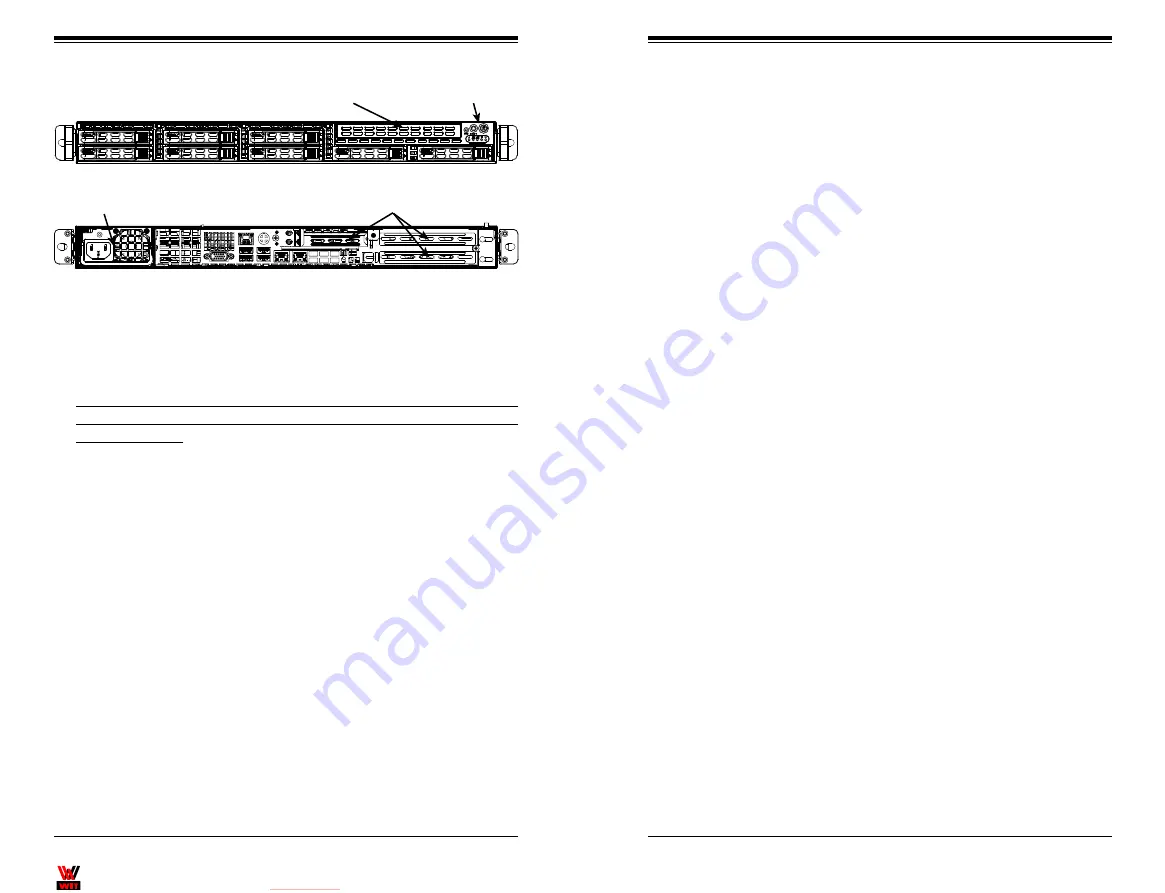
WIT Company – поставка серверов, СХД,
сетевого оборудования, лицензионного ПО
Chapter 6: Advanced Chassis Setup
6-3
6-2
SUPERSERVER 1028R-TDW USER'S MANUAL
Figure 6-1. Chassis: Front and Rear Views
6-2 Control Panel
The control panel (located on the front of the chassis) must be connected to the JF1
connector on the serverboard to provide you with system status indications. These
wires have been bundled together as a ribbon cable to simplify the connection.
Connect the cable from JF1 on the serverboard to the appropriate header on the
Control Panel PCB (printed circuit board). Make sure the red wire plugs into pin 1
on both connectors.
Pull all excess cabling out of the airflow path.
The control panel LEDs inform you of system status. See "Chapter 3: System
Interface" for details on the LEDs and the control panel buttons. Details on JF1 can
be found in "Chapter 5: Advanced Serverboard Setup."
6-3 System Fans
Five 4-cm counter-rotating fans provide the cooling for the system. Each fan unit is
actually made up of two fans joined back-to-back, which rotate in opposite directions.
This counter-rotating action generates exceptional airflow and works to dampen
vibration levels. The SC113TQ chassis provides an additional open fan housing,
where an extra system fan may be added for optimal cooling.
It is very important that the chassis top cover is properly installed and making a
good seal in order for the cooling air to circulate properly through the chassis and
cool the components. See Figure 6-2 System Fan Failure.
Adding a System Fan
1. Turn off the power to the system and unplug the power cord.
2. Remove the chassis cover then remove the dummy fan from the fan tray.
3. Place the new fan into the vacant space in the housing while making sure
the arrows on the top of the fan (indicating air direction) point in the same
direction as the arrows on the other fans.
4. Connect the fan wires to the fan header on the serverboard.
5. Power up the system and check that the fan is working properly before
replacing the chassis cover.
System Fan Failure
Fan speed is controlled by system temperature via IPMI. If a fan fails, the remaining
fans will ramp up to full speed. Replace any failed fan at your earliest convenience
with the same type and model (the system can continue to run with a failed fan).
The SC113TQ chassis includes five pre-installed fans. An additional open space is
available so that another fan may be added.
Replacing a System Fan (Figure 6-2)
1. Open the chassis while the system is running to determine which fan has
failed. Never run the server for an extended period of time with the chassis
open.
2. Turn off the power to the system and unplug the power cord.
3. Remove the failed fan's wiring from the fan header on the serverboard.
4. Lift the failed fan from the chassis and pull it completely out.
5. Place the new fan into the vacant space in the housing while making sure
the arrows on the top of the fan (indicating air direction) point in the same
direction as the arrows on the other fans.
6. Reconnect the fan wires to the same chassis fan header as the previous fan.
7. Power up the system and check that the fan is working properly and that
the LED on the control panel has turned off. Finish by replacing the chassis
cover.
DVD-ROM Drive (Optional)
Hot-Swap Drive Bays (8)
Control Panel
PCI Expansion Slots (w/ Riser Cards)
I/O Ports
Power Supply
Summary of Contents for SUPERSERVER 1028R-TDW
Page 1: ...WIT RU WIT Company SUPERSERVER 1028R TDW USER S MANUAL 1 0a...
Page 9: ...WIT RU WIT Company 1 6 SUPERSERVER 1028R TDW User s Manual Notes...
Page 15: ...WIT RU WIT Company 2 10 SUPERSERVER 1028R TDW USER S MANUAL Notes...
Page 19: ...WIT RU WIT Company 3 6 SUPERSERVER 1028R TDW USER S MANUAL Notes...
Page 30: ...WIT RU WIT Company 4 20 SUPERSERVER 1028R TDW User s Manual Notes...
Page 73: ...WIT RU WIT Company A 2 SUPERSERVER 1028R TDW User s Manual Notes...
















































